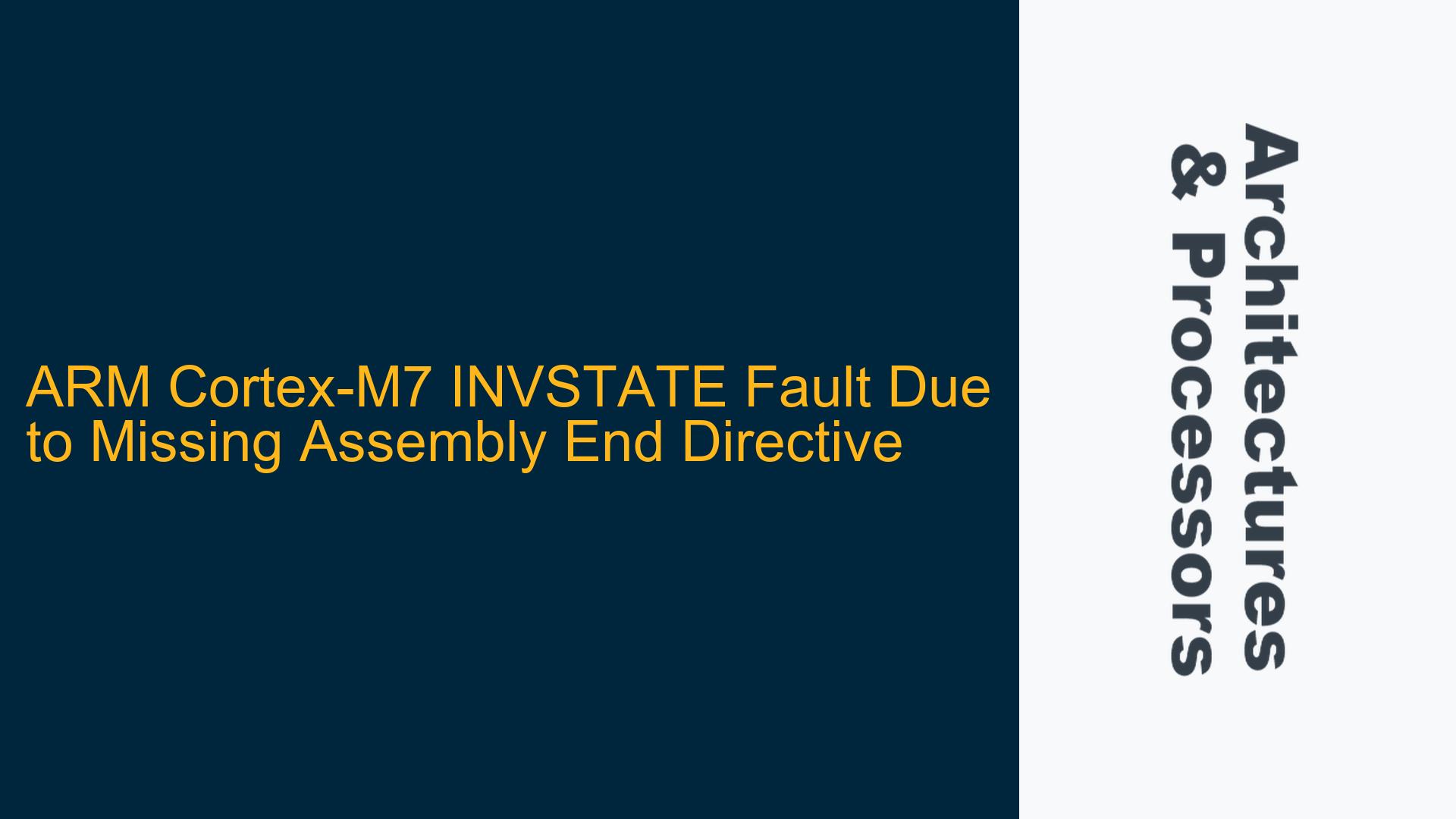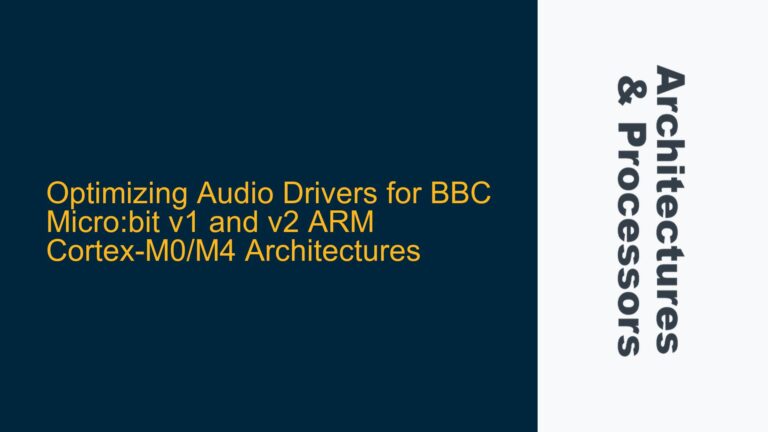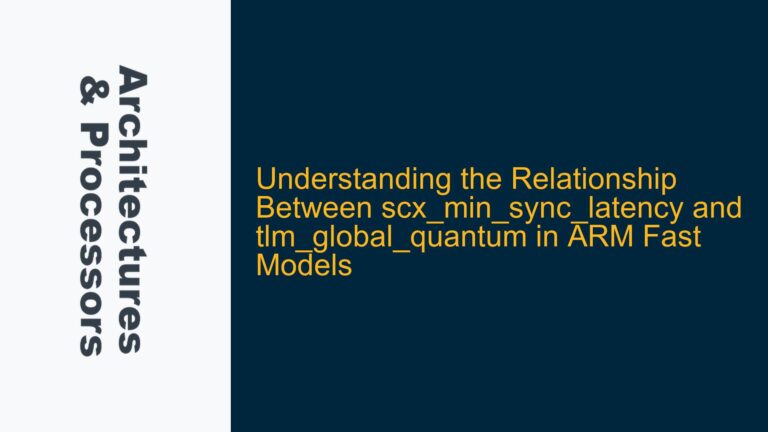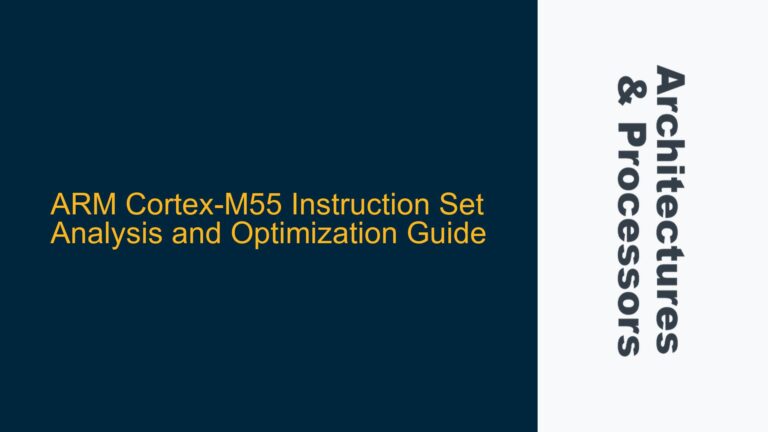ARM Cortex-M7 INVSTATE Fault During Assembly Function Execution
The ARM Cortex-M7 processor is a high-performance embedded processor designed for real-time applications. It is based on the ARMv7-M architecture, which supports both Thumb and ARM instruction sets. However, the Cortex-M7 primarily operates in Thumb mode, which is a more compact instruction set designed for efficiency in embedded systems. When executing assembly code, the processor relies on proper directives and syntax to ensure correct operation. A common issue that arises during the execution of assembly functions is the Invalid State Usage Fault (INVSTATE), which occurs when the processor encounters an instruction that it cannot decode or execute due to an invalid state.
The INVSTATE fault is specifically triggered when the processor attempts to execute an instruction that is not valid for the current processor state. In the context of the Cortex-M7, this often happens when the processor is expecting Thumb instructions but encounters ARM instructions, or when the assembly code is not properly terminated with the correct directives. The fault is indicated by the INVSTATE bit in the HardFault Status Register (HFSR), which can be examined to diagnose the issue.
In the case described, the assembly function was written in Thumb mode, but the INVSTATE fault was triggered when the function was executed. The root cause was traced back to the absence of an end directive at the conclusion of the assembly function. The end directive is crucial because it signals to the assembler and the processor that the function has completed, and it ensures that the processor remains in the correct state for subsequent instructions. Without this directive, the processor may attempt to execute invalid or unintended instructions, leading to the INVSTATE fault.
Missing End Directive in Thumb-Mode Assembly Code
The primary cause of the INVSTATE fault in this scenario was the omission of the end directive at the end of the assembly function. The end directive serves as a marker that indicates the conclusion of the assembly code. In Thumb mode, the processor expects a specific sequence of instructions and directives to maintain its state. When the end directive is missing, the processor may continue to interpret memory contents as instructions, leading to unpredictable behavior and potential faults.
The Cortex-M7 processor operates in Thumb mode by default, and it expects all instructions to be valid Thumb instructions. Thumb instructions are 16-bit or 32-bit in length, and they are designed to be more compact than traditional ARM instructions, which are 32-bit. The processor uses the least significant bit (LSB) of the program counter (PC) to determine whether it is executing Thumb or ARM instructions. If the LSB is set to 1, the processor assumes Thumb mode; if it is set to 0, it assumes ARM mode. In the case of the Cortex-M7, the LSB should always be set to 1, as the processor does not support ARM mode.
When the end directive is missing, the assembler may not properly terminate the function, leading to the processor attempting to execute data or padding as if it were instructions. This can result in the processor encountering an invalid instruction, which triggers the INVSTATE fault. Additionally, the absence of the end directive can cause the processor to misinterpret the boundaries of the function, leading to incorrect branching or return behavior.
Another potential cause of the INVSTATE fault is the use of incorrect or unsupported instructions in the assembly code. While the Cortex-M7 supports a wide range of Thumb instructions, there are certain instructions that are not valid in Thumb mode. If the assembly code contains such instructions, the processor will trigger an INVSTATE fault when it attempts to execute them. This can occur if the assembly code is written for a different ARM architecture or if there are errors in the instruction encoding.
Properly Terminating Assembly Functions with End Directives and Ensuring Thumb Mode Compliance
To resolve the INVSTATE fault caused by the missing end directive, it is essential to ensure that all assembly functions are properly terminated with the appropriate directive. In most assemblers, the end directive is used to indicate the end of the assembly code. For example, in the ARM assembler, the directive END is used to mark the end of the assembly file. Similarly, in the GNU assembler, the directive .end is used for the same purpose. By including this directive at the end of the assembly function, the assembler and the processor are informed that the function has concluded, and no further instructions should be executed.
In addition to the end directive, it is important to ensure that the assembly code is written in Thumb mode and that all instructions are valid for the Cortex-M7 architecture. The Thumb mode can be explicitly specified using the .thumb directive in the GNU assembler or the THUMB directive in the ARM assembler. This ensures that the assembler generates Thumb instructions and that the processor remains in Thumb mode during execution.
To further diagnose and prevent INVSTATE faults, developers should examine the HardFault Status Register (HFSR) and the Configuration and Control Register (CCR) to determine the exact cause of the fault. The HFSR provides information about the type of fault that occurred, while the CCR can be used to enable or disable certain fault handling mechanisms. By analyzing these registers, developers can identify whether the fault was caused by an invalid instruction, a misaligned memory access, or another issue.
In cases where the assembly code is embedded within a C file using the __asm keyword, the compiler typically handles the generation of Thumb instructions and the inclusion of necessary directives. This can explain why the assembly function executed correctly when included in a C file but failed when placed in a separate assembly file. The compiler ensures that the assembly code is properly formatted and terminated, reducing the likelihood of INVSTATE faults.
To summarize, the INVSTATE fault in the Cortex-M7 processor can be resolved by ensuring that assembly functions are properly terminated with the end directive and that all instructions are valid for Thumb mode. Developers should also verify that the assembly code is explicitly set to Thumb mode using the appropriate directives and that the processor state is correctly maintained throughout the execution of the function. By following these steps, the risk of INVSTATE faults can be minimized, and the reliability of the embedded system can be improved.
Detailed Analysis of Cortex-M7 INVSTATE Fault Handling and Prevention
The Cortex-M7 processor provides several mechanisms for handling and diagnosing faults, including the INVSTATE fault. When a fault occurs, the processor enters the HardFault exception handler, which can be used to analyze the cause of the fault and take appropriate action. The HardFault Status Register (HFSR) contains bits that indicate the type of fault that occurred, such as the INVSTATE bit, which is set when an invalid instruction is encountered.
In addition to the HFSR, the Configuration and Control Register (CCR) can be used to enable or disable certain fault handling mechanisms. For example, the CCR contains a bit that controls whether the processor should generate a fault for unaligned memory accesses. By configuring the CCR, developers can customize the fault handling behavior of the processor to suit their specific application requirements.
To prevent INVSTATE faults, developers should ensure that all assembly code is written in Thumb mode and that the end directive is included at the end of each function. Additionally, developers should verify that the assembly code does not contain any invalid or unsupported instructions. This can be done by carefully reviewing the assembly code and comparing it against the instruction set architecture (ISA) for the Cortex-M7 processor.
In cases where the assembly code is embedded within a C file, the compiler typically handles the generation of Thumb instructions and the inclusion of necessary directives. However, when writing standalone assembly files, developers must take care to ensure that the code is properly formatted and terminated. This includes using the appropriate directives to specify Thumb mode and to mark the end of the assembly function.
By following these best practices, developers can reduce the likelihood of INVSTATE faults and ensure that their embedded systems operate reliably. Additionally, by leveraging the fault handling mechanisms provided by the Cortex-M7 processor, developers can quickly diagnose and resolve any issues that arise during the execution of assembly code.
Conclusion
The INVSTATE fault in the ARM Cortex-M7 processor is a common issue that can occur when executing assembly code. The fault is typically caused by the omission of the end directive at the end of the assembly function or by the use of invalid or unsupported instructions. To resolve the fault, developers should ensure that all assembly functions are properly terminated with the end directive and that the code is written in Thumb mode. Additionally, developers should verify that the assembly code does not contain any invalid instructions and that the processor state is correctly maintained throughout the execution of the function.
By following these steps, developers can prevent INVSTATE faults and ensure that their embedded systems operate reliably. Furthermore, by leveraging the fault handling mechanisms provided by the Cortex-M7 processor, developers can quickly diagnose and resolve any issues that arise during the execution of assembly code. This approach not only improves the reliability of the system but also enhances the overall development process by reducing the time spent debugging and troubleshooting.






